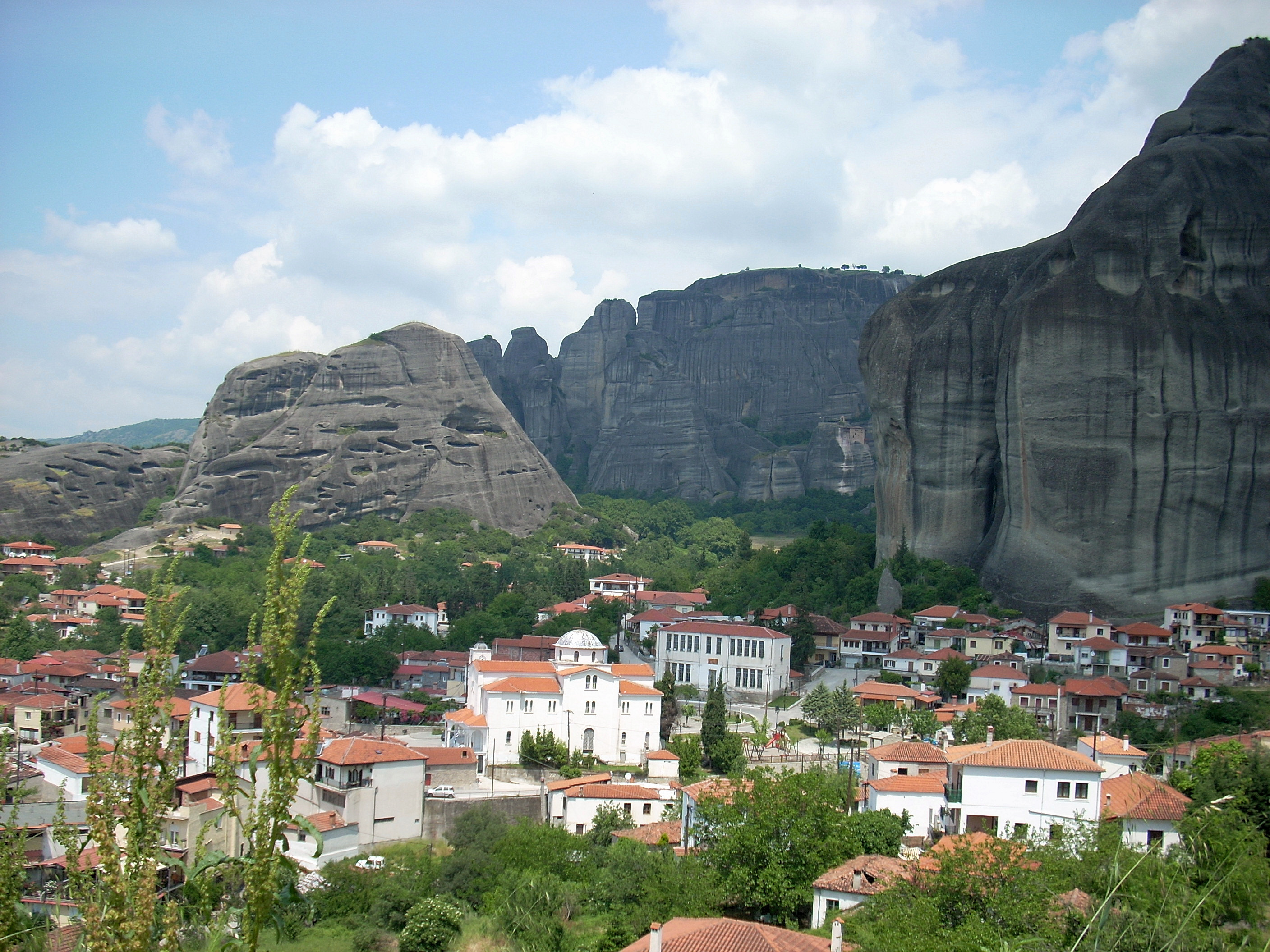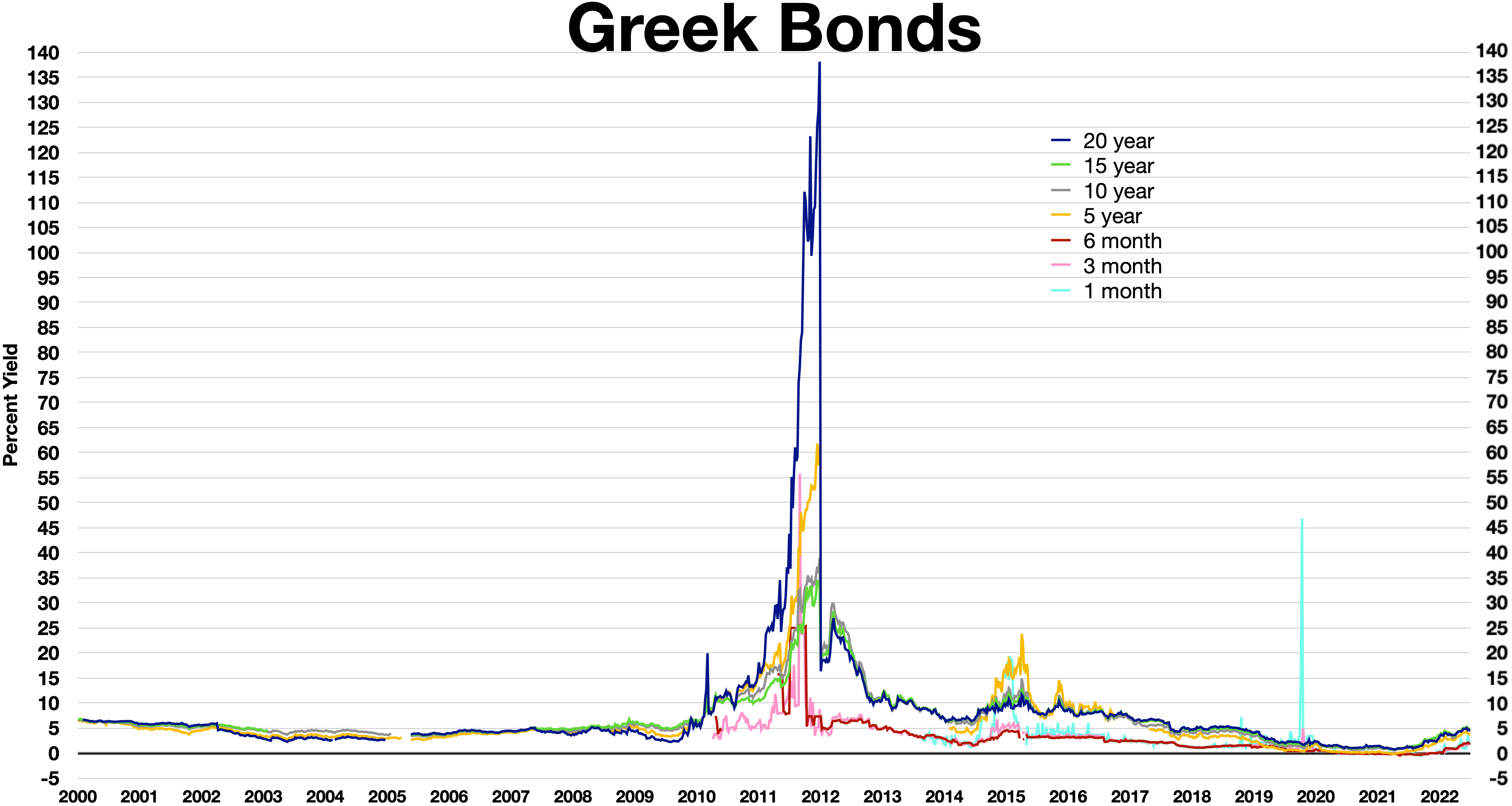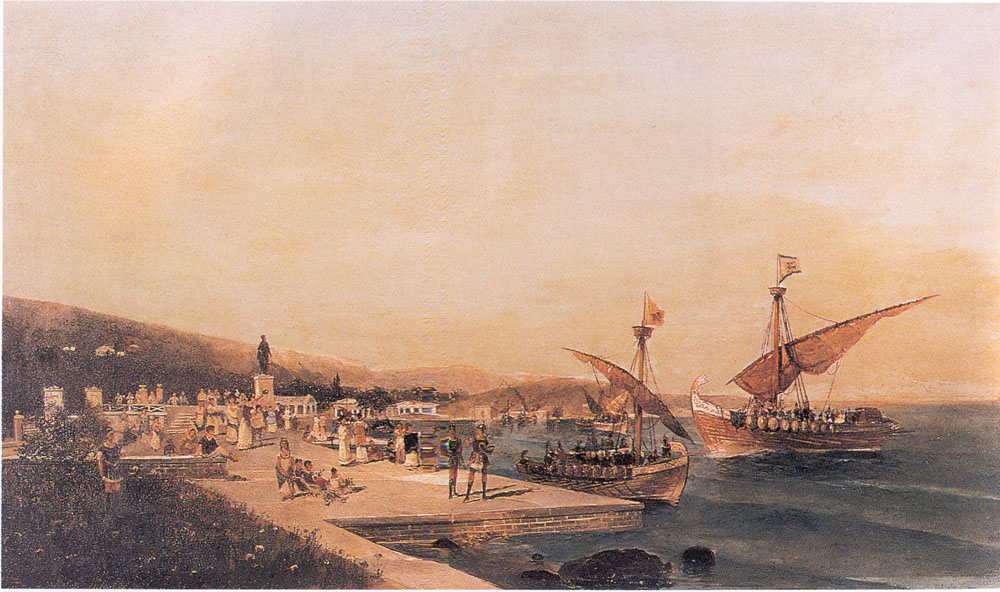|
Kalambaka Railway Station
Kalambaka railway station ( el, Σιδηροδρομικός σταθμός Καλαμπάκας, Sidirodromikós stathmós Kalambákas) is the main railway station in Kalabaka, in the Trikala regional unit, Thessaly. Opened on 16 June 1886 by the Thessaly Railways (now part of OSE) as its first terminal station. Today Hellenic Train operates Regional Express services to destinations across Greece. It is currently the most northwesterly part of the Greek railway network in operation. History The station opened on 16 June 1886 as a terminus of Thessaly Railways. The original station building (and the line) was designed by the Italian Evaristo de Chirico, (father of Giorgio de Chirico). The line was authorised by the Greek government under the law AMH’/22.6.1882. soon after the liberation of Central Greece from the Ottomans. After the First World War, the Greek state planned the ambitious construction of several new rail lines and links, including a standard gauge line from Kalam ... [...More Info...] [...Related Items...] OR: [Wikipedia] [Google] [Baidu] |
Kalambaka
Kalabaka ( el, Καλαμπάκα, ''Kalabáka'', alternative transliterations are ''Kalambaka'' and ''Kalampaka'') is a town and seat of the municipality of Meteora in the Trikala regional unit, part of Thessaly in Greece. The population was 12,000 at the 2011 census, of which 8,330 in the town proper. The Meteora monasteries are located near the town. Kalabaka is the northwestern terminal of the old Thessaly Railways, now part of OSE. History A Greek inscription on the wall of one of the town's oldest churches (Saint John the Baptist) testifies to the existence of an ancient Greek settlement under the name Aiginion. In the 10th century AD, it was known as Stagoi (Σταγοί), a Byzantine fortress and bishopric (the name is still in use for the town by the Greek Orthodox Church). Of its medieval monuments, only the cathedral, the Church of the Dormition, survives. It was a late 11th- or early 12th-century building, built on the remains of an earlier, late antique chu ... [...More Info...] [...Related Items...] OR: [Wikipedia] [Google] [Baidu] |
Central Greece
Continental Greece ( el, Στερεά Ελλάδα, Stereá Elláda; formerly , ''Chérsos Ellás''), colloquially known as Roúmeli (Ρούμελη), is a traditional geographic region of Greece. In English, the area is usually called Central Greece, but the equivalent Greek term (Κεντρική Ελλάδα, ''Kentrikí Elláda'') is more rarely used. It includes the southern part of the Greek mainland (sans the Peloponnese), as well as the offshore island of Euboea. Since 1987, its territory has been divided among the administrative regions of Central Greece and Attica, and the regional unit (former prefecture) of Aetolia-Acarnania in the administrative region of Western Greece. Etymology The region has traditionally been known as ''Roúmeli'' (Ρούμελη), a name deriving from the Turkish word '' Rūm-eli'', meaning "the land of the Rūm he Romans, i.e. the Byzantine Greeks">Byzantine_Greeks.html" ;"title="he Romans, i.e. the Byzantine Greeks">he Romans, i.e. the ... [...More Info...] [...Related Items...] OR: [Wikipedia] [Google] [Baidu] |
Volos Railway Station
Volos railway station ( el, Σιδηροδρομικός Σταθμός Βόλου, Sidirodromikos Stathmos Volos) is a railway station in Volos, Greece. located within the city itself (close to the harbour). Opened on 22 April 1884 by the Thessaly Railways (now part of OSE). Today Hellenic Train operates three daily local trains to Larissa. Previously Thessaly Railways operated a narrow gauge service to Mileai from Volos, however this service now starts and terminates from Ano Lechonia (12 km from Volos). History The station was opened on 22 April 1884, an inauguration led by King George. The station building (and the line) was designed by the Italian Evaristo de Chirico, (father of Giorgio de Chirico) soon after the liberation of Central Greece from the Ottomans. Part of the station still functions in this picturesque 1884 structure, reminiscent of a stately home to some. The building, built between 1882 and 1883 under Evaristo De Chirico, served as the administrative h ... [...More Info...] [...Related Items...] OR: [Wikipedia] [Google] [Baidu] |
Larissa
Larissa (; el, Λάρισα, , ) is the capital and largest city of the Thessaly region in Greece. It is the fifth-most populous city in Greece with a population of 144,651 according to the 2011 census. It is also capital of the Larissa regional unit. It is a principal agricultural centre and a national transport hub, linked by road and rail with the port of Volos, the cities of Thessaloniki and Athens. The municipality of Larissa has 162,591 inhabitants, while the regional unit of Larissa reached a population of 284,325 (). Legend has it that Achilles was born here. Hippocrates, the "Father of Medicine", died here. Today, Larissa is an important commercial, transportation, educational, agricultural and industrial centre of Greece. Geography There are a number of highways including E75 and the main railway from Athens to Thessaloniki (Salonika) crossing through Thessaly. The region is directly linked to the rest of Europe through the International Airport of Central Greece ... [...More Info...] [...Related Items...] OR: [Wikipedia] [Google] [Baidu] |
TrainOSE
Hellenic Train S.A., formerly TrainOSE S.A. ( el, ΤραινΟΣΕ Α.Ε., pronounced ''trenosé'') is a private railway company in Greece which currently operates passenger and freight trains on OSE lines. TrainOSE was acquired in September 2017 by the Italian national railway company, Ferrovie dello Stato Italiane. The company was a subsidiary of the Hellenic Railways Organisation (OSE) until 2008, when it became an independent state-owned company until its privatisation in 2017. Hellenic Train employs train crews, operators and manages the most of rail services throughout the Greek railway network, leasing rolling stock owned by GAIOSE except for ETR 470 trains. In 2022 the company rebranded as Hellenic Train. History The company was a subsidiary of the Hellenic Railways Organisation (OSE) and has been since 2005. Before 2005 it had been an in-house service of OSE. In 2008 the company became an independent state-owned company. In 2017 it became a wholly-owned subsidiary of ... [...More Info...] [...Related Items...] OR: [Wikipedia] [Google] [Baidu] |
Greek Government-debt Crisis
Greece faced a sovereign debt crisis in the aftermath of the financial crisis of 2007–2008. Widely known in the country as The Crisis ( Greek: Η Κρίση), it reached the populace as a series of sudden reforms and austerity measures that led to impoverishment and loss of income and property, as well as a small-scale humanitarian crisis. In all, the Greek economy suffered the longest recession of any advanced mixed economy to date. As a result, the Greek political system has been upended, social exclusion increased, and hundreds of thousands of well-educated Greeks have left the country. The Greek crisis started in late 2009, triggered by the turmoil of the world-wide Great Recession, structural weaknesses in the Greek economy, and lack of monetary policy flexibility as a member of the Eurozone. The crisis included revelations that previous data on government debt levels and deficits had been underreported by the Greek government: the official forecast for the 2009 budg ... [...More Info...] [...Related Items...] OR: [Wikipedia] [Google] [Baidu] |
Thessaloniki
Thessaloniki (; el, Θεσσαλονίκη, , also known as Thessalonica (), Saloniki, or Salonica (), is the second-largest city in Greece, with over one million inhabitants in its Thessaloniki metropolitan area, metropolitan area, and the capital city, capital of the geographic regions of Greece, geographic region of Macedonia (Greece), Macedonia, the administrative regions of Greece, administrative region of Central Macedonia and the Decentralized Administration of Macedonia and Thrace. It is also known in Greek language, Greek as (), literally "the co-capital", a reference to its historical status as the () or "co-reigning" city of the Byzantine Empire alongside Constantinople. Thessaloniki is located on the Thermaic Gulf, at the northwest corner of the Aegean Sea. It is bounded on the west by the delta of the Vardar, Axios. The Thessaloniki (municipality), municipality of Thessaloniki, the historical center, had a population of 317,778 in 2021, while the Thessaloniki metro ... [...More Info...] [...Related Items...] OR: [Wikipedia] [Google] [Baidu] |
Athens
Athens ( ; el, Αθήνα, Athína ; grc, Ἀθῆναι, Athênai (pl.) ) is both the capital and largest city of Greece. With a population close to four million, it is also the seventh largest city in the European Union. Athens dominates and is the capital of the Attica region and is one of the world's oldest cities, with its recorded history spanning over 3,400 years and its earliest human presence beginning somewhere between the 11th and 7th millennia BC. Classical Athens was a powerful city-state. It was a centre for the arts, learning and philosophy, and the home of Plato's Academy and Aristotle's Lyceum. It is widely referred to as the cradle of Western civilization and the birthplace of democracy, largely because of its cultural and political influence on the European continent—particularly Ancient Rome. In modern times, Athens is a large cosmopolitan metropolis and central to economic, financial, industrial, maritime, political and cultural life in Gre ... [...More Info...] [...Related Items...] OR: [Wikipedia] [Google] [Baidu] |
Palaiofarsalos Railway Station
Palaiofarsalos railway station ( el, Σιδηροδρομικός Σταθμός Παλαιοφαρσάλου, Sidirodromikós Stathmós Palaiofarsálou) is a railway station near Farsala in Larissa regional unit, Greece. It is located in the village Stavros, west of Farsala. It is situated at the junction of the main Piraeus–Platy railway and the branch line to Trikala and Kalambaka. It is served by intercity trains between Athens and Thessaloniki and by local trains to Kalambaka.TrainOSE 2013 timetable History The Palaiofarsalos station opened in 1908 as Demerli at the meeting point between the metric line of the Thessaly Railways (S.Th.) and the standard line of the Piraeus-Demerli-Sinoron Railway (S.P.D.S.) or “Larissaykos”. After the |
Hellenic State Railways
Hellenic State Railways or SEK ( el, Σιδηρόδρομοι Ελληνικού Κράτους, ''Sidirodromi Ellinikou Kratous''; Σ.Ε.Κ.) was a Greek public sector entity (legal person of public law, el, Ν.Π.Δ.Δ.) which was established in 1920 and operated most Greek railway lines until 1970. History The Hellenic State Railways took over the standard gauge railway line from Piraeus to Papapouli at the pre-1912 borders, the extension from Papapouli to Platy and most of the former Ottoman railway lines that were within the Greek borders after 1919. These lines were: * ''Piraeus, Demerli & Frontiers Railway'' ( el, Σιδηρόδρομος Πειραιώς-Δεμερλή-Συνόρων), also known as * Part of the former ''Thessaloniki & Monastir Railway'' (french: Chemin de fer de Salonique à Monastir or SM) * Part of or CO, between Thessaloniki and Idomeni. The line from Alexandroupolis to Ormenio was transferred to the French-Hellenic Railway Company (, CFFH) of Ev ... [...More Info...] [...Related Items...] OR: [Wikipedia] [Google] [Baidu] |
Volos
Volos ( el, Βόλος ) is a coastal port city in Thessaly situated midway on the Greek mainland, about north of Athens and south of Thessaloniki. It is the sixth most populous city of Greece, and the capital of the Magnesia regional unit of the Thessaly Region. Volos is also the only outlet to the sea from Thessaly, the country's largest agricultural region. With a population of 144,449 (2011), the city is an important industrial centre, and its port provides a bridge between Europe and Asia. Volos is the newest of the Greek port cities, with a large proportion of modern buildings erected following catastrophic earthquakes in 1955. It includes the municipal units of Volos, Nea Ionia and Iolkos, as well as smaller suburban communities. The economy of the city is based on manufacturing, trade, services and tourism. Home to the University of Thessaly, the city also offers facilities for conferences, exhibitions and major sporting, cultural and scientific events. Volos parti ... [...More Info...] [...Related Items...] OR: [Wikipedia] [Google] [Baidu] |
Veroia
Veria ( el, Βέροια or Βέρροια), officially transliterated Veroia, historically also spelled Berea or Berœa, is a city in Central Macedonia, in the geographic region of Macedonia, northern Greece, capital of the regional unit of Imathia. It is located north-northwest of the capital Athens and west-southwest of Thessaloniki. Even by the standards of Greece, Veria is an old city; first mentioned in the writings of Thucydides in 432 BC, there is evidence that it was populated as early as 1000 BC. Veria was an important possession for Philip II of Macedon (father of Alexander the Great) and later for the Romans. Apostle Paul famously preached in the city, and its inhabitants were among the first Christians in the Empire. Later, under the Byzantine and Ottoman empires, Veria was a center of Greek culture and learning. Today Veria is a commercial center of Central Macedonia, the capital of the regional unit of Imathia and the seat of a Church of Greece Metropolitan b ... [...More Info...] [...Related Items...] OR: [Wikipedia] [Google] [Baidu] |







_Sarakli-Stavros_in_Central_Makedonia_(Greece)_during_WW1.jpg)

